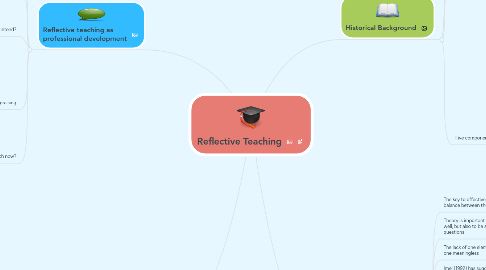
1. Reflective teaching in foreign language contexts
1.1. Suggested procedures for reflective teaching in EFL contexts
1.2. Language teachers cannot see themselves as passive agents in the field.
1.3. the only way to do this is taking time to think and reflect on their practices to foster more effective learning in their students
1.4. they bring to class personal styles for teaching, personal perceptions of students needs and even personal assumptions of what good teaching is.
1.5. Pennigton (1992) has defined reflective teaching as that of “mirroring experience” and as the “input and output for development”.
1.5.1. They are the starting point towards a positive pedagogy.
1.5.2. Teacher development is related to personal development, particularly personal development as a teacher
1.6. Reflective teaching is enriching, empowering, and enduring
1.7. Wajnryb (1999) has explained that observing our own teaching is a way of discovering the classroom from a perspective other than the one we actually engage in; it is a way of providing focus and clarity; it is a means of collecting classroom-observation data and information about teaching.
1.8. Self-observation provides meta-language to teachers ( a language to talk about with other colleagues about classroom situations and procedures
2. Reflective teaching as professional development
2.1. Received knowledge.
2.1.1. In this the trainee becomes acquainted with the vocabulary of the subject and the matching concepts, research findings, theories, and skills which are widely accepted as being part of the necessary intellectual content of the profession.
2.2. Experiential knowledge.
2.2.1. Here, the trainee will have developed knowledge-in-action by practice of the profession, and will have had, moreover, the opportunity to reflect on that knowledge-in-action.
2.3. “What do I do as a teacher?”
2.3.1. In the mapping stage or preliminary stage, to self-inquire as an individual and internally observe beliefs, attitudes, methodologies, etc.
2.4. What did I intend?
2.4.1. Deepens into what his/her aims were in the teaching/learning process to determine successes or faults
2.4.2. Oblige him/her to uncover situations and engage into discussions and reflection with colleagues by sharing ideas and thoughts.
2.5. this model deals with appraising
2.5.1. This stage leads the reflective teacher to implement new practice, observe, analyze and evaluate it, and determine if the changes implemented have worked or not (cited in Pickett, 1996).
2.5.2. the teacher will inquire on new ways of teaching when he finds him/herself asking “How might I teach differently?
2.5.3. There is a growth towards innovative actions to improve problems encountered in previous experiences.
2.6. What and how shall I teach now?
3. Historical Background
3.1. The beliefs and actions of teachers in the interactive learning process could be explored through an approach based on Dewey’s ideas. Richardson (1990)
3.2. Involves stopping, slowing down, noticing, examining, analyzing and inquiring about aspects and complexities encountered in different situations. Leitch and Day (2000)
3.3. Donald Schön
3.3.1. Reflection-in-action relates thinking and doing
3.3.1.1. These two actions (thinking/doing) lead to modifying teaching practice with the purpose of improving learning
3.3.1.2. “competent practitioner learns to think on his/her feet and is able to improvise as s/he takes in new information and/or encounters the unexpected” (Pickett, 1996,p. 1).
3.3.1.3. Internal conversation of the practitioner where he/she takes hold of the process/ or experience that has occurred, reframes it, and tries to experience it from a different perspective.
3.3.2. Reflection-on-action
3.3.2.1. teachers’ thoughtful considerations and retrospective analysis of their performance in order to gain knowledge from experience” (cited in Leitch and Day, 2000).
3.3.2.2. The practitioner reflects on the tacit understandings and assumptions s/he holds and subjects them to scrutiny in order to achieve deeper understanding of instructor/student roles, motivations and behaviors
3.4. Five components of reflective thinking
3.4.1. 1. Recognizing an educational dilemma
3.4.2. 2. Responding to a dilemma by recognizing both the similarities to other situations and special qualities of the particular situation
3.4.3. 3. Framing and reframing the dilemma
3.4.4. 4. Experimenting with the dilemma to discover the consequences and implications of various solutions
3.4.5. 5. Examining the intended and unintended consequences of an implemented solution and reevaluating the solution by determining whether the consequences are desirable or not. (cited in Pickett, 1996, p.1)

